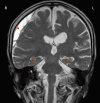Recurrent Psychotic Depression Associated with Chronic Subdural Haematoma: A Case Report
- PMID: 38868841
- PMCID: PMC11165614
- DOI: 10.29399/npa.28519
Recurrent Psychotic Depression Associated with Chronic Subdural Haematoma: A Case Report
Abstract
Chronic subdural hematomas (CSDH) with isolated psychiatric presentation are rare. In this paper, we report a case of 77-year-old-female patient who had psychotic depression after repetitive head trauma without any neurological symptoms. The brain magnetic resonance imaging revealed an 20 mm subdural hematoma in the right frontoparietal region and a 7 mm subdural hematoma in the left frontal region. The psychiatric symptoms improved within the first week after evacuation but relapsed with the occurrence of right sided pneumocephalus. In the follow up, with the disappearance of the pneumocephalus, the psychiatric symptoms improved. It should be kept in mind that isolated psychiatric symptoms can be seen due to subdural hematoma and evacuation of the hematoma has an important role in improving the psychiatric symptoms.
Keywords: Depression; pneumocephalus; psychosis; subdural hematoma.
Copyright: © 2024 Turkish Neuropsychiatric Society.
Conflict of interest statement
Conflict of Interest: The authors declared that there is no conflict of interest.
Figures



Similar articles
-
Development of a delayed chronic subdural haematoma 3 years after traumatic brain injury with urinary incontinence: a case report.Ann Med Surg (Lond). 2024 May 27;86(7):4262-4267. doi: 10.1097/MS9.0000000000002221. eCollection 2024 Jul. Ann Med Surg (Lond). 2024. PMID: 38989191 Free PMC article.
-
A case report and technical tip of chronic subdural hematoma treated by the placement of a subdural peritoneal shunt.Trauma Case Rep. 2017 Jan 11;7:7-10. doi: 10.1016/j.tcr.2017.01.005. eCollection 2017 Feb. Trauma Case Rep. 2017. PMID: 30014025 Free PMC article.
-
Lumbar Subdural Hematoma Detected After Surgical Treatment of Chronic Intracranial Subdural Hematoma.World Neurosurg. 2020 Feb;134:472-476. doi: 10.1016/j.wneu.2019.11.053. Epub 2019 Nov 19. World Neurosurg. 2020. PMID: 31756510
-
Concomitant Intracranial Chronic Subdural Hematoma and Spinal Subdural Hematoma: A Case Report and Literature Review.World Neurosurg. 2016 Jun;90:706.e1-706.e9. doi: 10.1016/j.wneu.2016.03.020. Epub 2016 Mar 18. World Neurosurg. 2016. PMID: 26996734 Review.
-
Concomitant Intracranial and Lumbar Chronic Subdural Hematoma Treated by Fluoroscopic Guided Lumbar Puncture: A Case Report and Literature Review.Neurol Med Chir (Tokyo). 2018 Apr 15;58(4):178-184. doi: 10.2176/nmc.cr.2017-0177. Epub 2018 Feb 23. Neurol Med Chir (Tokyo). 2018. PMID: 29479039 Free PMC article. Review.
References
-
- Sahyouni R, Goshtasbi K, Mahmoodi A, Tran DK, Chen JW. Chronic subdural hematoma:a historical and clinical perspective. World Neurosurg. 2017;108:948–953. - PubMed
-
- Alarcon RD, Thweatt RW. A case of subdural hematoma mimicking severe depression with conversion-like symptoms. Am J Psychiatry. 1983;140(10):1360–1361. - PubMed
-
- Nagatomo I, Ueyama K, Fukuzako H, Matsumoto K. Three cases of chronic subdural hematoma with depressive state. Jpn J Psychiatry Neurol. 1990;44(4):703–707. - PubMed
-
- Elie M, Primeau F, Cole MG. Chronic subdural hematoma in the elderly:a case report. J Geriatr Psychiatry Neurol. 1996;9(2):100–101. - PubMed
Publication types
LinkOut - more resources
Full Text Sources
